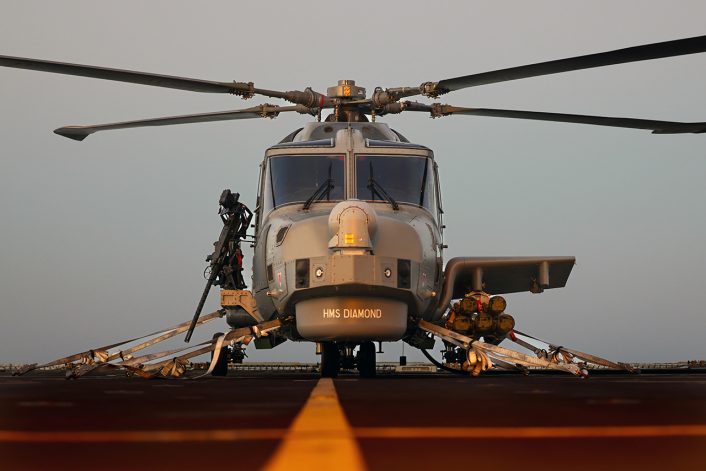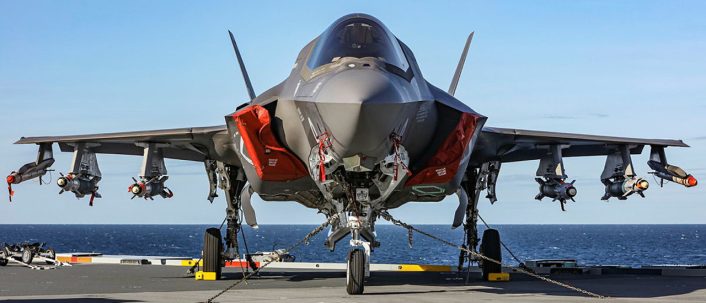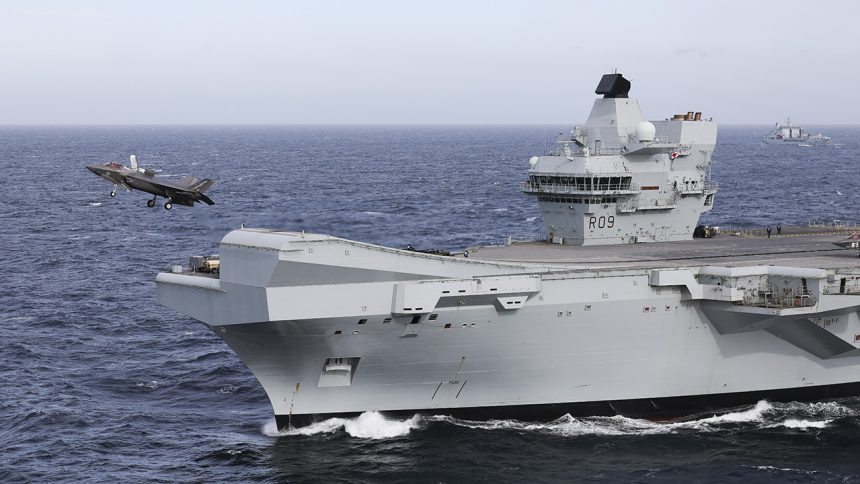Royal Navy aircraft carrier HMS Prince of Wales is due to depart HMNB Portsmouth this weekend for Exercise Strike Warrior, hosting F-35Bs from 809 Naval Air Squadron and 617 Squadron. This will be the first time that 809 NAS F-35s operate from an aircraft carrier.
The Queen Elizabeth class aircraft carrier HMS Prince of Wales (R09) will depart from its homebase of HMNB Portsmouth this weekend, subject to weather conditions. The ship will embark F-35B Lightning II aircraft from RAF Marham’s 617 Squadron and 809 Naval Air Squadron (NAS). This will mark the first deployment of 809 NAS on board a ship, only weeks after the squadron undertook their first independent sortie.
This comes following a work-up period where the ship completed Operational Sea Training off the UK’s southwestern coast, testing the crew’s abilities in navigation, seamanship, damage control, firefighting, and other basic operational tasks. Prince of Wales was seen anchored in St Ives Bay, Cornwall, for a brief period before returning to Portsmouth on Sept. 20, 2024.
The massive Royal Navy aircraft carrier HMS Prince of Wales anchored off St Ives at sunrise this morning. pic.twitter.com/LyEdGPYg8J
— Greg Martin (@photogregmartin) September 15, 2024
Also joining the ship will be Wildcat HMA2 helicopters from 815 Naval Air Squadron. These maritime helicopters, based at RNAS Yeovilton in Somerset, have notably now been equipped with the capability of launching various types of missiles via newly developed weapon wings. Currently these wings are used for carrying the Martlet Lightweight Multirole Missile and the Sea Venom anti-ship missile. Exercise Strike Warrior will see the Wildcats developing operational tactics to employ the Martlet missile in an air defence role. Previous tests have demonstrated the missile’s capabilities in targeting and destroying small aerial targets like unmanned aerial vehicles. Defending from this type of threat is of particular focus following the situation in the Red Sea. A Martlet equipped Wildcat was operated by HMS Diamond in this theatre, but it did not, as far as is publicly known, engage any threats with their missiles.

These Wildcats will likely also have to cover the ship’s anti-submarine warfare, search and rescue, and general utility requirements, as flying of the Royal Navy’s fleet of Merlin helicopters has been paused following the tragic fatal crash of a Merlin HC4 earlier in September.
Alongside ensuring the ship’s readiness to deploy on frontline operations at short notice, Exercise Strike Warrior will be preparing HMS Prince of Wales, its crew, and its air wing, ahead of the scheduled Carrier Strike Group 2025 deployment to the Indo-Pacific. The UK government recently confirmed that HMS Prince of Wales is due to be the carrier taking part in this mammoth deployment, which will stretch as far as Japan.
While 809 Naval Air Squadron marks its historic moment, the first time the squadron will deploy to sea since the Falklands War of 1982, the Royal Air Force’s 617 Squadron will also make history of its own. On Sept. 12 2024, command of the squadron was passed from Wing Commander Stew Campbell, Royal Air Force, to Lieutenant Colonel Mike Carty of the Royal Marines. This is not only the first time a Royal Marine has taken command of a Royal Air Force badged squadron, but also the first time a Royal Marine has headed up any fast jet squadron.
Carty has twenty four years of service in the Royal Marines, flying the Harrier GR9 from Invincible class aircraft carriers HMS Ark Royal and HMS Illustrious before transferring to an exchange posting with VMFA-211, United States Marine Corps, flying the AV-8B Harrier II. During this exchange, he took part in the squadron’s deployment to the Middle East for Operation Inherent Resolve, the United States’ military contribution to the fight against Daesh. For his service in this conflict, Carty was awarded the US Air Medal. Upon his return to the UK, he served as an instructor on the Hawk T2 training aircraft at RAF Valley, before joining the F-35 force at RAF Marham via the F-35 Operational Conversion Unit, 207 Squadron.
Lt Col Mike Carty RM is the first Royal Marine to command a fast jet squadron. He took command of 617 Sqn ‘The Dambusters’ from Wg Cdr Stew Campbell RAF on Thursday 12th September.#RMfamily pic.twitter.com/lTKLInVYzu
— RMA – The Royal Marines Charity (@theRMcharity) September 26, 2024
While each UK F-35 squadron is marked either as a Royal Air Force or Royal Navy unit, it is important to note that all squadrons operate on a joint basis with serving personnel from both forces (the Royal Marines falling under the Royal Navy in this context). A member of the Royal Navy has already commanded the RAF’s 617 Squadron, and 207 Squadron is currently headed by Commander Tim Flatman, Royal Navy. It is likely that at some point a member of the Royal Air Force might take command of 809 Naval Air Squadron, which is currently the only Royal Navy badged F-35 squadron.
UK F-35s – A Slow Burn
As HMS Queen Elizabeth marks its tenth year afloat, the UK’s renewed carrier strike capability is still in its infancy. While the aircraft carriers themselves have suffered from several setbacks, the UK fleet of delivered F-35B aircraft still stands at only 34 airframes. The initial commitments to order 138 F-35s over the lifetime of the program stand on unsteady ground. At present, the government has committed to a figure of 74 F-35s by the year 2033. This includes the initial order of 48 as well as a follow-on order of 27 which is currently under negotiation.
With a new government taking the reins in June 2024, many questions have been raised as to what plans may be made for the UK’s armed forces in the upcoming Strategic Defence Review, due to be published in 2025. Some media speculation has raised the idea that the new government might scrap the F-35, and carrier strike in general, and place their priorities elsewhere in the armed forces, though it should be stressed that there appears to be no basis to confirm whether this is actually being considered.
The easy answer would appear to simply be ordering more F-35s in a shorter timeframe, but this is an oversimplification of the situation. Current F-35s, including those delivered to the UK so far, have only a limited capability to deploy UK specific weaponry. So far, only ASRAAM and Paveway IV have been integrated with the F-35B for the UK’s specific needs. This leaves the UK’s F-35s with no medium to long range air-to-air missiles, nor any stand-off air-to-surface capability.

The upcoming SPEAR air to surface missile might not be ready to deploy from the F-35 until 2028, and integration of the Meteor air-to-air missile currently in service with the RAF’s Typhoons onto the F-35 is not expected to be complete until 2027. While current spec jets can be upgraded to align with the capabilities built into newer blocks of F-35s, this is an expensive and inconvenient process, and the RAF would almost certainly rather not take on too many of these jets before they are fully capable.
While the UK is a major partner in the F-35 program, its relatively small order of F-35s, and the fact that development and weapons integration is largely a US controlled process, means it has a limited ability to fast-track the specific developments that are required for the RAF/RN fleet. Seeking a larger hand in controlling these elements of their aircraft would be a massive benefit brought by the GCAP program, otherwise known as Tempest. Ensuring no hindrance for the integration of domestically developed weapons and technology is also a prime reason why the Israeli government struck their unique deal for their own special F-35I variant.
A successful completion of Exercise Strike Warrior ahead of the Strategic Defence Review will be important to demonstrate the ongoing feasibility of carrier strike and long worldwide deployments like the one planned for Prince of Wales next year.









